Preparation of Palladium Nanoparticles Decorated Polyethyleneimine/Polycaprolactone Composite Fibers Constructed by Electrospinning with Highly Efficient and Recyclable Catalytic Performances
Abstract
:1. Introduction
2. Results and Discussion
2.1. Characterization of PEI/PCL@PdNPs Composites
2.2. Catalytic Performance of PEI/PCL@PdNPs Composites
3. Materials and Methods
3.1. Materials
3.2. Preparation of PEI/PCL@PdNPs Composites
3.3. Catalytic Performance of PEI/PCL@PdNPs Composite
3.4. Characterization
4. Conclusions
Supplementary Materials
Author Contributions
Funding
Conflicts of Interest
References
- Amezquita-Garcia, H.J.; Razo-Flores, E.; Cervantes, F.J.; Rangel-Mendez, J.R. Activated carbon fibers as redox mediators for the increased reduction of nitroaromatics. Carbon 2013, 55, 276–284. [Google Scholar] [CrossRef]
- El-Sheikh, S.M.; Ismail, A.A.; Al-Sharab, J.F. Catalytic reduction of p-nitrophenol over precious metals/highly ordered mesoporous silica. New J. Chem. 2013, 37, 2399–2407. [Google Scholar] [CrossRef]
- Dieckmann, M.S.; Gray, K.A. A comparison of the degradation of 4-nitrophenol via direct and sensitized photocatalysis in TiO2 slurries. Water Res. 1996, 30, 1169–1183. [Google Scholar] [CrossRef]
- Marais, E.; Nyokong, T. Adsorption of 4-nitrophenol onto Amberlite® IRA-900 modified with metallophthalocyanines. J. Hazard. Mater. 2008, 152, 293–301. [Google Scholar] [CrossRef]
- Liu, N.; Li, H.; Ding, F.; Xiu, Z.; Liu, P.; Yu, Y. Analysis of biodegradation by-products of nitrobenzene and aniline mixture by a cold-tolerant microbial consortium. J. Hazard. Mater. 2013, 260, 323–329. [Google Scholar] [CrossRef] [PubMed]
- Zhang, L.; Zheng, S.; Kang, D.E.; Shin, J.Y.; Suh, H.; Kim, I. Synthesis of multi-amine functionalized hydrogel for preparation of noble metal nanoparticles: Utilization as highly active and recyclable catalysts in reduction of nitroaromatics. RSC Adv. 2013, 3, 4692–4703. [Google Scholar] [CrossRef]
- Boothroyd, S.R.; Kerr, M.A. A mild and efficient method for the preparation of anilines from nitroarenes. Tetrahedron Lett. 1995, 36, 2411–2414. [Google Scholar] [CrossRef]
- Pérez-Lorenzo, M. Palladium nanoparticles as efficient catalysts for Suzuki cross-coupling reactions. J. Phys. Chem. Lett. 2012, 3, 167–174. [Google Scholar] [CrossRef]
- Hildebrand, H.; Mackenzie, K.; Kopinke, F.D. Highly active Pd-on-magnetite nanocatalysts for aqueous phase hydrodechlorination reactions. Environ. Sci. Technol. 2009, 43, 3254–3259. [Google Scholar] [CrossRef]
- Esumi, K.; Isono, R.; Yoshimura, T. Preparation of PAMAM− and PPI−Metal (silver, platinum, and palladium) nanocomposites and their catalytic activities for reduction of 4-nitrophenol. Langmuir 2004, 20, 237–243. [Google Scholar] [CrossRef]
- Lin, Y.; Qiao, Y.; Wang, Y.; Yan, Y.; Huang, J. Self-assembled laminated nanoribbon-directed synthesis of noble metallic nanoparticle-decorated silica nanotubes and their catalytic applications. J. Mater. Chem. 2012, 22, 18314–18320. [Google Scholar] [CrossRef]
- Okaa, S.; Kamegawa, T.; Mori, K.; Yamashita, H. An electroless deposition technique for the synthesis of highly active and nano-sized Pd particles on silica nanosphere. Catal. Today 2012, 185, 109–112. [Google Scholar] [CrossRef]
- Li, Y.; Fan, X.; Qi, J.; Ji, J.; Wang, S.; Zhang, G.; Zhang, F. Palladium nanoparticle-graphene hybrids as active catalysts for the Suzuki reaction. Nano Res. 2010, 3, 429–437. [Google Scholar] [CrossRef] [Green Version]
- Hermans, S.; Bruyr, V.; Devillers, M. A templating effect of carbon nanomaterials on the synthesis of Pd nanoparticles by covalent grafting onto surface O-groups. J. Mater. Chem. 2012, 22, 14479–14486. [Google Scholar] [CrossRef]
- Liu, J.; Li, Y.Q.; Zheng, W.J. Synthesis of immobilized nanopalladium on polymer-supported Schiff base, and study of its catalytic activity in the Suzuki–Miyaura reaction. Monatsh. Chem. 2009, 140, 1425. [Google Scholar] [CrossRef]
- Domènech, B.; Muñoz, M.; Muraviev, D.N.; Macanás, J. Polymer-stabilized palladium nanoparticles for catalytic membranes: Ad hoc polymer fabrication. Nanoscale Res. Lett. 2011, 6, 406. [Google Scholar] [CrossRef]
- Lebaschi, S.; Hekmati, M.; Veisi, H. Green synthesis of palladium nanoparticles mediated by black tea leaves (Camellia sinensis) extract: Catalytic activity in the reduction of 4-nitrophenol and Suzuki-Miyaura coupling reaction under ligand-free conditions. J. Colloid Interf. Sci. 2017, 485, 223–231. [Google Scholar] [CrossRef]
- Wu, X.; Lu, C.; Zhang, W.; Yuan, G.; Xiong, R.; Zhang, X. A novel reagentless approach for synthesizing cellulose nanocrystal-supported palladium nanoparticles with enhanced catalytic performance. J. Mater. Chem. A 2013, 1, 8645–8652. [Google Scholar] [CrossRef]
- Chen, X.; Cai, Z.; Chen, X.; Oyama, M. AuPd bimetallic nanoparticles decorated on graphene nanosheets: Their green synthesis, growth mechanism and high catalytic ability in 4-nitrophenol reduction. J. Mater. Chem. A 2014, 2, 5668–5674. [Google Scholar] [CrossRef]
- Le, X.; Dong, Z.; Li, X.; Zhang, W.; Le, M.; Ma, J. Fibrous nano-silica supported palladium nanoparticles: An efficient catalyst for the reduction of 4-nitrophenol and hydrodechlorination of 4-chlorophenol under mild conditions. Catal. Commun. 2015, 59, 21–25. [Google Scholar] [CrossRef]
- Bhardwaj, N.; Kundu, S.C. Electrospinning: A fascinating fiber fabrication technique. Biotechnol. Adv. 2010, 28, 325–347. [Google Scholar] [CrossRef] [PubMed]
- Huang, Z.M.; Zhang, Y.Z.; Kotaki, M.; Ramakrishna, S. A review on polymer nanofibers by electrospinning and their applications in nanocomposites. Compos. Sci. Technol. 2003, 63, 2223–2253. [Google Scholar] [CrossRef]
- Shariful, M.I.; Sharif, S.B.; Lee, J.J.L.; Habiba, U.; Ang, B.C.; Amalina, M.A. Adsorption of divalent heavy metal ion by mesoporous-high surface area chitosan/poly (ethylene oxide) nanofibrous membrane. Carbohyd. Polym. 2017, 157, 57–64. [Google Scholar] [CrossRef] [PubMed]
- Su, C.; Li, Y.; Dai, Y.; Gao, F.; Tang, K.; Cao, H. Fabrication of three-dimensional superhydrophobic membranes with high porosity via simultaneous electrospraying and electrospinning. Mater. Lett. 2016, 170, 67–71. [Google Scholar] [CrossRef]
- Habiba, U.; Afifi, A.M.; Salleh, A.; Ang, B.C. Chitosan/(polyvinyl alcohol)/zeolite electrospun composite nanofibrous membrane for adsorption of Cr6+, Fe3+ and Ni2+. J. Hazard. Mater. 2017, 322, 182–194. [Google Scholar] [CrossRef] [PubMed]
- Zhao, R.; Wang, Y.; Li, X.; Sun, B.; Wang, C. Synthesis of β-cyclodextrin-based electrospun nanofiber membranes for highly efficient adsorption and separation of methylene blue. ACS Appl. Mater. Inter. 2015, 7, 26649–26657. [Google Scholar] [CrossRef] [PubMed]
- Shang, C.; Li, M.; Wang, Z.; Wu, S.; Lu, Z. Electrospun nitrogen-doped carbon nanofibers encapsulating cobalt nanoparticles as efficient oxygen reduction reaction catalysts. ChemElectroChem 2016, 3, 1437–1445. [Google Scholar] [CrossRef]
- Ye, J.S.; Liu, Z.T.; Lai, C.C.; Lo, C.T.; Lee, C.L. Diameter effect of electrospun carbon fiber support for the catalysis of Pt nanoparticles in glucose oxidation. Chem. Eng. J. 2016, 283, 304–312. [Google Scholar] [CrossRef]
- Zhu, M.M.; Han, J.Q.; Wang, F.; Shao, W.; Xiong, R.H.; Zhang, Q.L.; Pan, H.; Yang, Y.; Samal, S.K.; Zhang, F.; et al. Electrospun nanofibers membranes for effective air filtration. Macromol. Mater. Eng. 2017, 302, 1600353. [Google Scholar] [CrossRef]
- Jiang, S.; Hou, H.; Agarwal, S.; Greiner, A. Polyimide nanofibers by “Green” electrospinning via aqueous solution for filtration applications. ACS Sustain. Chem. Eng. 2016, 4, 4797–4804. [Google Scholar] [CrossRef]
- Yoshimoto, H.; Shin, Y.M.; Terai, H.; Vacanti, J.P. A biodegradable nanofiber scaffold by electrospinning and its potential for bone tissue engineering. Biomaterials 2003, 24, 2077–2082. [Google Scholar] [CrossRef]
- Xu, T.; Liang, Z.; Ding, B.; Feng, Q.; Fong, H. Polymer blend nanofibers containing polycaprolactone as biocompatible and biodegradable binding agent to fabricate electrospun three-dimensional scaffolds/structures. Polymer 2018, 151, 299–306. [Google Scholar] [CrossRef]
- Baker, S.R.; Banerjee, S.; Bonin, K.; Guthold, M. Determining the mechanical properties of electrospun poly-ε-caprolactone (PCL) nanofibers using AFM and a novel fiber anchoring technique. Mater. Sci. Eng. C 2016, 59, 203–212. [Google Scholar] [CrossRef] [PubMed]
- Delyanee, M.; Solouk, A.; Akbari, S.; Seyedjafari, E. Modification of electrospun poly(L-lactic acid)/polyethylenimine nanofibrous scaffolds for biomedical application. Inter. J. Polym. Mater. 2018, 67, 247–257. [Google Scholar] [CrossRef]
- Guo, Y.; Xu, Y.T.; Gao, G.H.; Wang, T.; Zhao, B.; Fu, X.Z.; Sun, R.; Wong, C.P. Electro-oxidation of formaldehyde and methanol over hollow porous palladium nanoparticles with enhanced catalytic activity. Catal. Commun. 2015, 58, 40–45. [Google Scholar] [CrossRef]
- Guo, R.; Jiao, T.F.; Xing, R.R.; Chen, Y.; Guo, W.C.; Zhou, J.X.; Zhang, L.X.; Peng, Q.M. Hierarchical AuNPs-loaded Fe3O4/polymers nanocomposites constructed by electrospinning with enhanced and magnetically recyclable catalytic capacities. Nanomaterials 2017, 7, 317. [Google Scholar] [CrossRef]
- Zhang, Y.W.; Peng, H.H.; Huang, W.; Zhou, Y.F.; Zhang, X.H.; Yan, D.Y. Hyperbranched poly (amidoamine) as the stabilizer and reductant to prepare colloid silver nanoparticles in situ and their antibacterial activity. J. Phys. Chem. C 2008, 112, 2330–2336. [Google Scholar] [CrossRef]
- Li, C.L.; Su, Y.; Lv, X.Y.; Shi, H.J.; Yang, X.G.; Wang, Y.J. Enhanced ethanol electrooxidation of hollow Pd nanospheres prepared by galvanic exchange reactions. Mater. Lett. 2012, 69, 92–95. [Google Scholar] [CrossRef]
- Yang, L.; Hu, C.G.; Wang, J.L.; Yang, Z.X.; Guo, Y.M.; Bai, Z.Y.; Wang, K. Facile synthesis of hollow palladium/copper alloyed nanocubes for formic acid oxidation. Chem. Commun. 2011, 47, 8581–8583. [Google Scholar] [CrossRef]
- Ji, Y.; Ghosh, K.; Shu, X.Z.; Li, B.Q.; Sokolov, J.C.; Prestwich, G.D.; Clark, R.A.F.; Rafailovich, M.H. Electrospun three-dimensional hyaluronic acid nanofibrous scaffolds. Biomaterials 2006, 27, 3782–3792. [Google Scholar] [CrossRef]
- Konwer, S.; Boruah, R.; Dolui, S.K. Studies on conducting polypyrrole/graphene oxide composites as supercapacitor electrode. J. Electron. Mater. 2011, 40, 2248. [Google Scholar] [CrossRef]
- Yang, S.D.; Dong, J.; Yao, Z.H.; Shen, C.M.; Shi, X.Z.; Tian, Y.; Lin, S.X.; Zhang, X.G. One-pot synthesis of graphene-supported monodisperse Pd nanoparticles as catalyst for formic acid electro-oxidation. Sci. Rep. 2014, 4, 4501. [Google Scholar] [CrossRef] [PubMed]
- Zhu, Q.L.; Song, F.Z.; Wang, Q.J.; Tsumori, N.; Himeda, Y.; Autrey, T.; Xu, Q. A solvent-switched in situ confinement approach for immobilizing highly-active ultrafine palladium nanoparticles: Boosting catalytic hydrogen evolution. J. Mater. Chem. A 2018, 6, 5544–5549. [Google Scholar] [CrossRef]
- Jin, Z.; Nackashi, D.; Lu, W.; Kittrell, C.; Tour, J.M. Decoration, migration, and aggregation of palladium nanoparticles on graphene sheets. Chem. Mater. 2010, 22, 5695–5699. [Google Scholar] [CrossRef]
- Dong, Z.P.; Le, X.D.; Liu, Y.S.; Dong, C.X.; Ma, J.T. Metal organic framework derived magnetic porous carbon composite supported gold and palladium nanoparticles as highly efficient and recyclable catalysts for reduction of 4-nitrophenol and hydrodechlorination of 4-chlorophenol. J. Mater. Chem. A 2014, 2, 18775–18785. [Google Scholar] [CrossRef]
- Li, H.; Han, L.; Cooper-White, J.; Kim, I. Palladium nanoparticles decorated carbon nanotubes: Facile synthesis and their applications as highly efficient catalysts for the reduction of 4-nitrophenol. Green Chem. 2012, 14, 586–591. [Google Scholar] [CrossRef]
- Le, X.; Dong, Z.; Liu, Y.; Jin, Z.; Huy, T.D.; Le, M.; Ma, J. Palladium nanoparticles immobilized on core–shell magnetic fibers as a highly efficient and recyclable heterogeneous catalyst for the reduction of 4-nitrophenol and Suzuki coupling reactions. J. Mater. Chem. A 2014, 2, 19696–19706. [Google Scholar] [CrossRef]
- Kim, K.; Kim, K.L.; Shin, K.S. Co-reduced Ag/Pd bimetallic nanoparticles: Surface enrichment of Pd revealed by Raman spectroscopy. J. Phys. Chem. C 2011, 115, 14844–14851. [Google Scholar] [CrossRef]
- Abay, A.K.; Kuo, D.H.; Chen, X.; Saragih, A.D. A new V-doped Bi2(O,S)3 oxysulfide catalyst for highly efficient catalytic reduction of 2-nitroaniline and organic dyes. Chemosphere 2017, 189, 21–31. [Google Scholar] [CrossRef]
- Jana, S.; Ghosh, S.K.; Nath, S.; Pande, S.; Praharaj, S.; Panigrahi, S.; Basu, S.; Endo, T.; Pal, T. Synthesis of silver nanoshell-coated cationic polystyrene beads: A solid phase catalyst for the reduction of 4-nitrophenol. Appl. Catal. A-Gen. 2006, 313, 41–48. [Google Scholar] [CrossRef]
- Jiao, T.F.; Zhao, H.; Zhou, J.X.; Zhang, Q.R.; Luo, X.N.; Hu, J.; Peng, Q.M.; Yan, X.H. Self-Assembly Reduced Graphene Oxide Nanosheet Hydrogel Fabrication by Anchorage of Chitosan/Silver and Its Potential Efficient Application toward Dyes Degradation for Wastewater Treatments. ACS Sustain. Chem. Eng. 2015, 3, 3130–3139. [Google Scholar] [CrossRef]
- Guo, R.; Jiao, T.F.; Li, R.F.; Chen, Y.; Guo, W.C.; Zhang, L.X.; Zhou, J.X.; Zhang, Q.R.; Peng, Q.M. Sandwiched Fe3O4/carboxylate graphene oxide nanostructures constructed by layer-by-layer assembly for highly efficient and magnetically recyclable dye removal. ACS Sustain. Chem. Eng. 2018, 6, 1279–1288. [Google Scholar] [CrossRef]
- Wang, C.R.; Sun, S.X.; Zhang, L.X.; Yin, J.J.; Jiao, T.F.; Zhang, L.; Xu, Y.L.; Zhou, J.X.; Peng, Q.M. Facile preparation and catalytic performance characterization of AuNPs-loaded hierarchical electrospun composite fibers by solvent vapor annealing treatment. Colloid Surf. A 2019, 561, 283–291. [Google Scholar] [CrossRef]
- He, Y.; Wang, R.; Jiao, T.F.; Yan, X.Y.; Wang, M.L.; Zhang, L.X.; Bai, Z.H.; Zhang, Q.; Peng, Q.M. Facile Preparation of Self-Assembled Layered Double Hydroxide-Based Composite Dye Films as New Chemical Gas Sensors. ACS Sustain. Chem. Eng. 2019, 7, 10888–10899. [Google Scholar] [CrossRef]
- Feng, Y.; Jiao, T.F.; Yin, J.J.; Zhang, L.; Zhang, L.X.; Zhou, J.X.; Peng, Q.M. Facile Preparation of Carbon Nanotube-Cu2O Nanocomposites as New Catalyst Materials for Reduction of p-Nitrophenol. Nanoscale Res. Lett. 2019, 14, 78. [Google Scholar] [CrossRef]
- Chen, K.Y.; Jiao, T.F.; Li, J.K.; Han, D.X.; Wang, R.; Tian, G.J.; Peng, Q.M. Chiral Nanostructured Composite Films via Solvent-Tuned Self-Assembly and Their Enantioselective Performances. Langmuir 2019, 35, 3337–3345. [Google Scholar] [CrossRef] [PubMed]
- Chen, K.Y.; Yan, X.Y.; Li, J.K.; Jiao, T.F.; Cai, C.; Zou, G.D.; Wang, R.; Wang., M.L.; Zhang, L.X.; Peng, Q.M. Preparation of Self-Assembled Composite Films Constructed by Chemically-Modified MXene and Dyes with Surface-enhanced Raman Scattering Characterization. Nanomaterials 2019, 9, 284. [Google Scholar] [CrossRef]
- Sun, S.X.; Wang, C.R.; Han, S.Q.; Jiao, T.F.; Wang, R.; Yin, J.J.; Li, Q.; Wang, Y.Q.; Geng, L.J.; Yu, X.D.; et al. Interfacial nanostructures and acidichromism behaviors in self-assembled terpyridine derivatives Langmuir-Blodgett films. Colloid Surf. A 2019, 564, 1–9. [Google Scholar] [CrossRef]
- Huang, X.X.; Jiao, T.F.; Liu, Q.Q.; Zhang, L.X.; Zhou, J.X.; Li, B.B.; Peng, Q.M. Hierarchical electrospun nanofibers treated by solvent vapor annealing as air filtration mat for high-efficiency PM2.5 capture. Sci. China Mater. 2019, 62, 423–436. [Google Scholar] [CrossRef]
- Wang, C.R.; Yin, J.J.; Wang, R.; Jiao, T.F.; Huang, H.M.; Zhou, J.X.; Zhang, L.X.; Peng, Q.M. Facile preparation of self-assembled polydopamine-modified electrospun fibers for highly effective removal of organic dyes. Nanomaterials 2019, 9, 116. [Google Scholar] [CrossRef]
- Guo, R.; Wang, R.; Yin, J.J.; Jiao, T.F.; Huang, H.M.; Zhao, X.M.; Zhang, L.X.; Li, Q.; Zhou, J.X.; Peng, Q.M. Fabrication and highly efficient dye removal characterization of beta-cyclodextrin-based composite polymer fibers by electrospinning. Nanomaterials 2019, 9, 127. [Google Scholar] [CrossRef] [PubMed]
- Huang, X.X.; Wang, R.; Jiao, T.F.; Zou, G.D.; Zhan, F.K.; Yin, J.J.; Zhang, L.X.; Zhou, J.X.; Peng, Q.M. Facile Preparation of Hierarchical AgNP-Loaded MXene/Fe3O4/Polymer Nanocomposites by Electrospinning with Enhanced Catalytic Performance for Wastewater Treatment. ACS Omega 2019, 4, 1897–1906. [Google Scholar] [CrossRef]
- Yin, Y.R.; Ma, N.; Xue, J.; Wang, G.Q.; Liu, S.B.; Li, H.L.; Guo, P.Z. Insights into the Role of Poly(vinylpyrrolidone) in the Synthesis of Palladium Nanoparticles and Their Electrocatalytic Properties. Langmuir 2019, 35, 787–795. [Google Scholar] [CrossRef] [PubMed]
- Liu, K.; Yuan, C.Q.; Zou, Q.L.; Xie, Z.C.; Yan, X.H. Self-Assembled Zinc/Cystine-Based Chloroplast Mimics Capable of Photoenzymatic Reactions for Sustainable Fuel Synthesis. Angew. Chem. Int. Ed. 2017, 56, 7876–7880. [Google Scholar] [CrossRef] [PubMed]
- Yan, X.Y.; Wang, M.L.; Sun, X.; Wang, Y.H.; Shi, G.H.; Ma, W.L.; Hou, P. Sandwich-like Ag@Cu@CW SERS substrate with tunable nanogaps and component based on the Plasmonic nanonodule structures for sensitive detection crystal violet and 4-aminothiophenol. Appl. Surf. Sci. 2019, 479, 879–886. [Google Scholar] [CrossRef]
- Ma, K.; Chen, W.; Jiao, T.; Jin, X.; Sang, Y.; Yang, D.; Zhou, J.; Liu, M.; Duan, P. Boosting Circularly Polarized Luminescence of Small Organic Molecules via Multi-dimensional Morphology Control. Chem. Sci. 2019. [Google Scholar] [CrossRef]
- Liu, J.Z.; Bauer, A.J.P.; Li, B.B. Solvent vapor annealing: An efficient approach for inscribing secondary nanostructures onto electrospun fibers. Macromol. Rapid Comm. 2014, 35, 1503–1508. [Google Scholar] [CrossRef]
- Nasrollahzadeh, M.; Sajadi, S.M.; Honarmand, E.; Maham, M. Preparation of palladium nanoparticles using Euphorbia thymifolia L. leaf extract and evaluation of catalytic activity in the ligand-free Stille and Hiyama cross-coupling reactions in water. New J. Chem. 2015, 39, 4745–4752. [Google Scholar] [CrossRef]

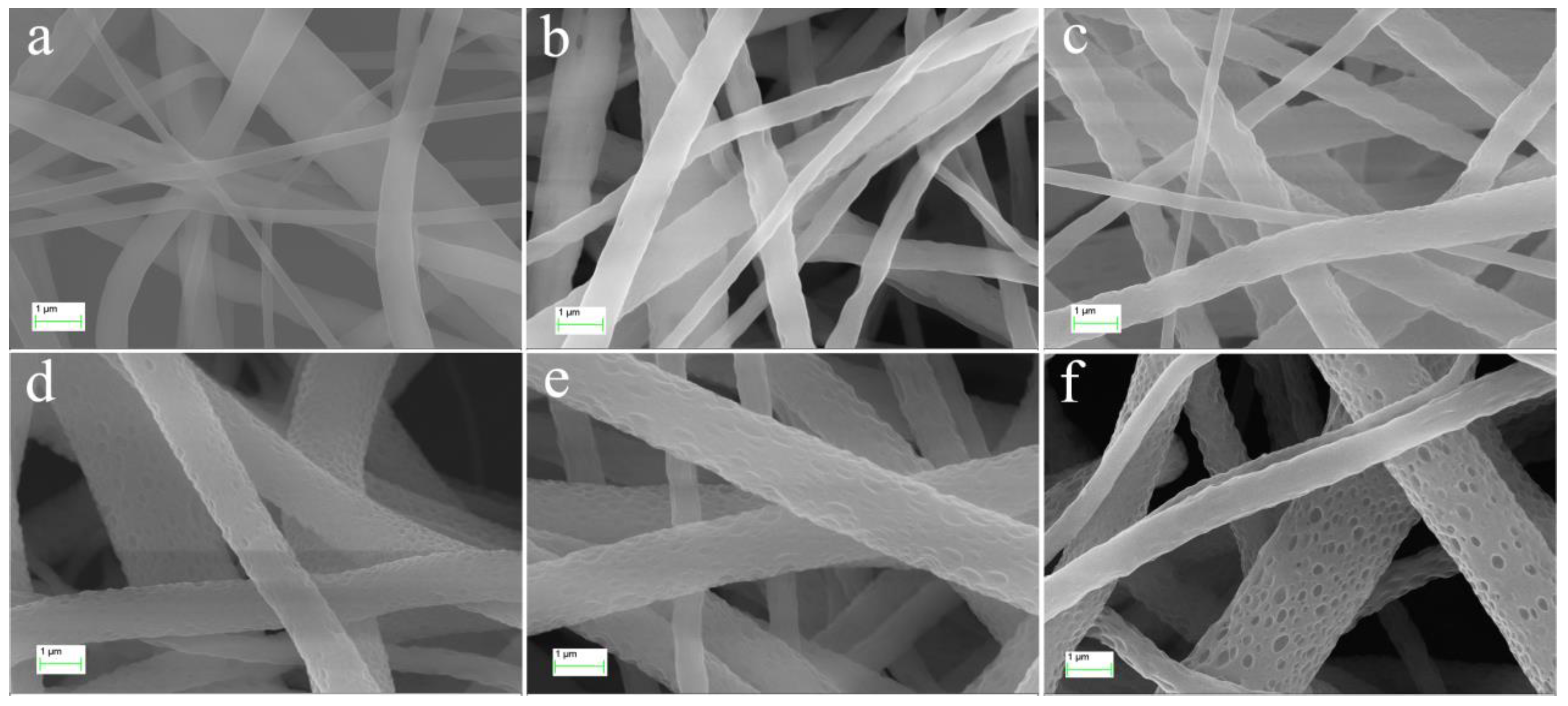
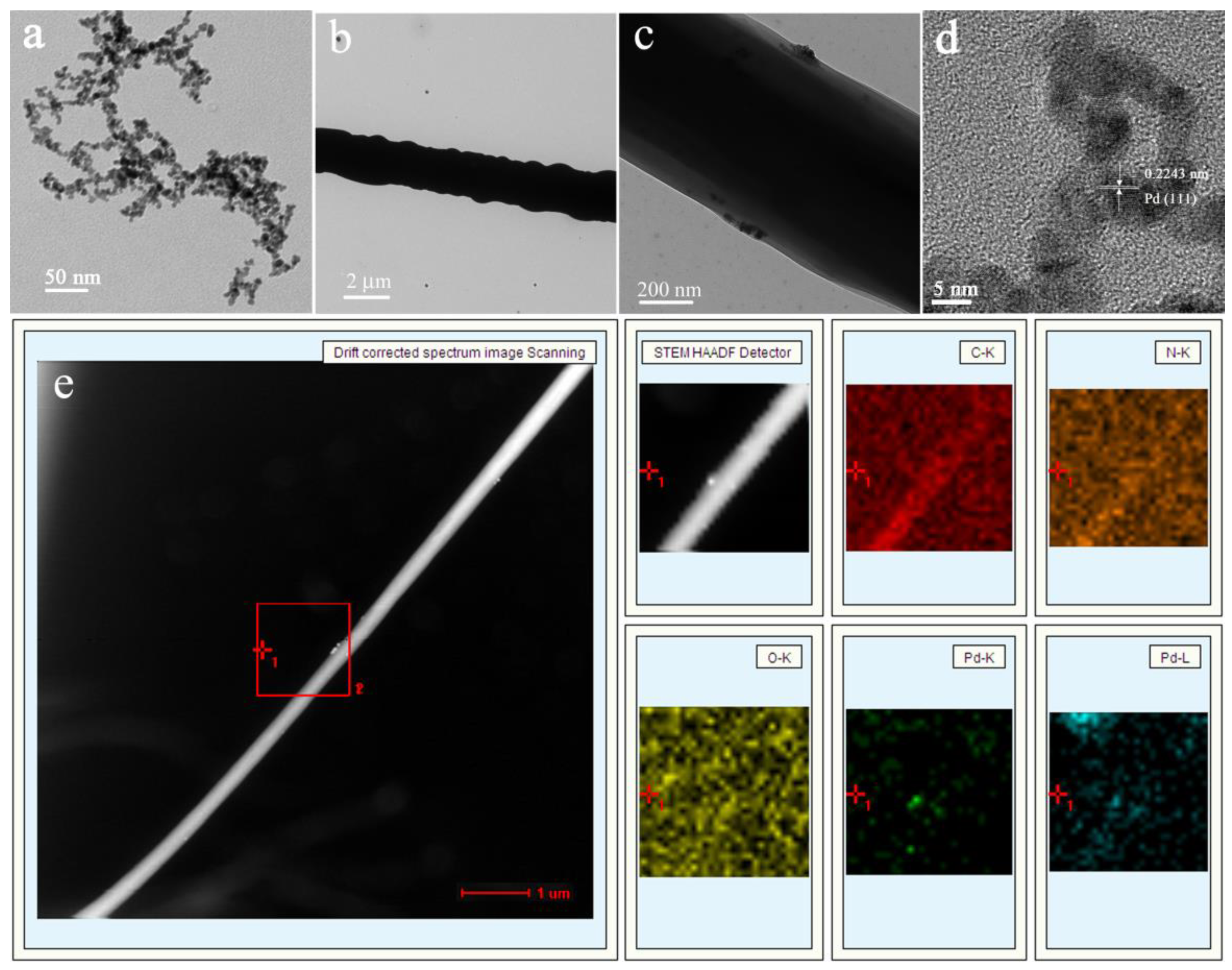
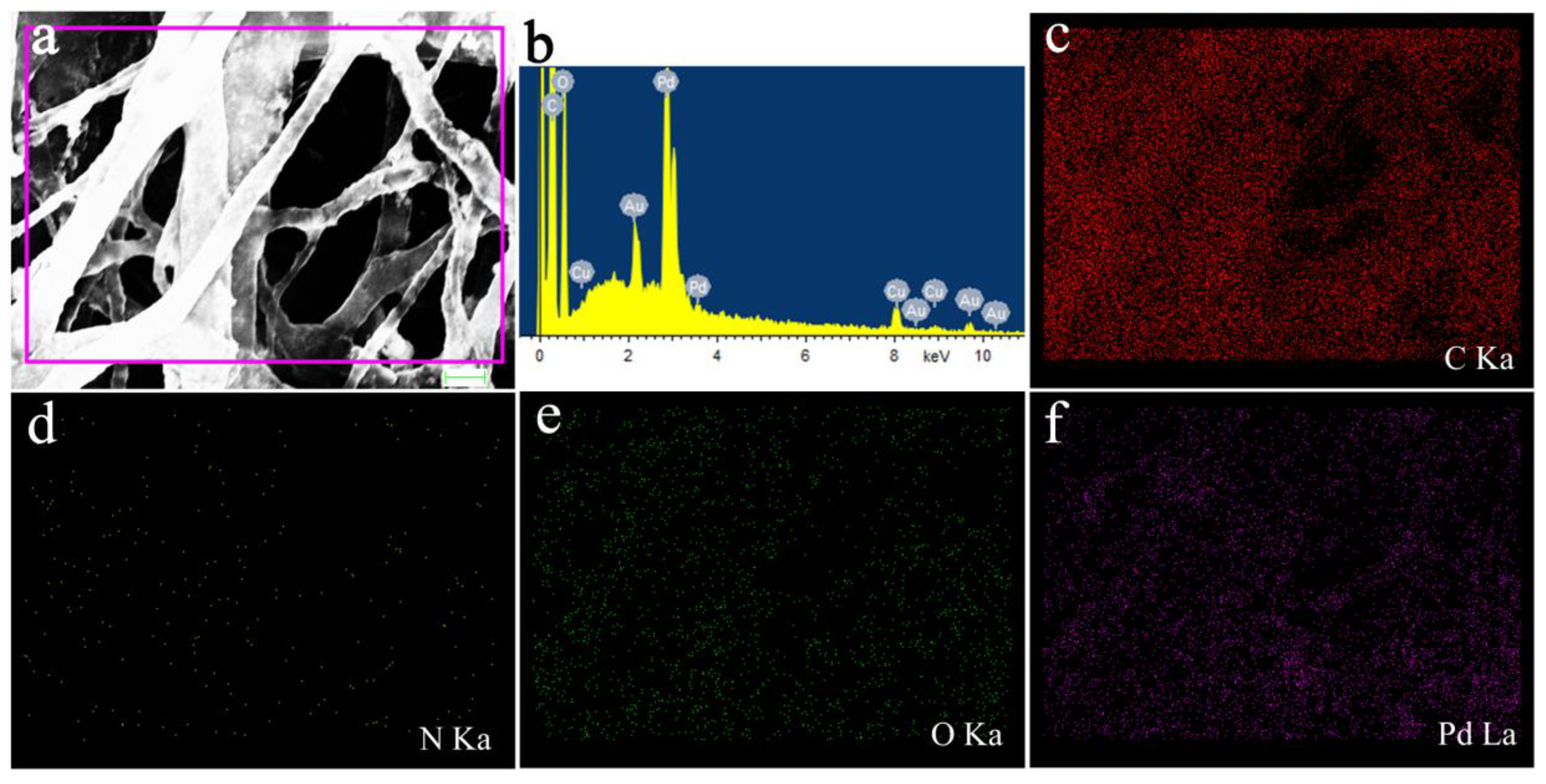
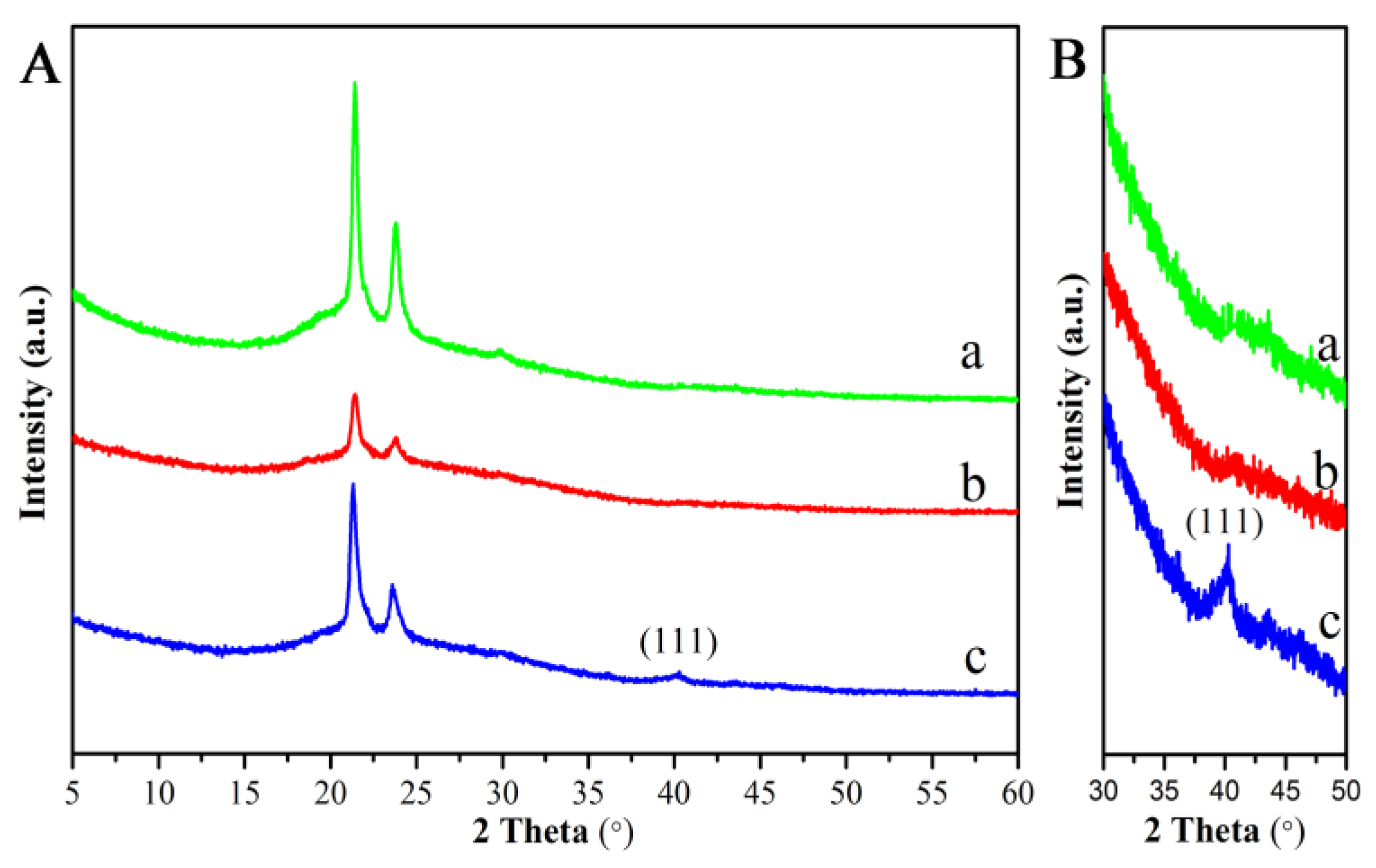
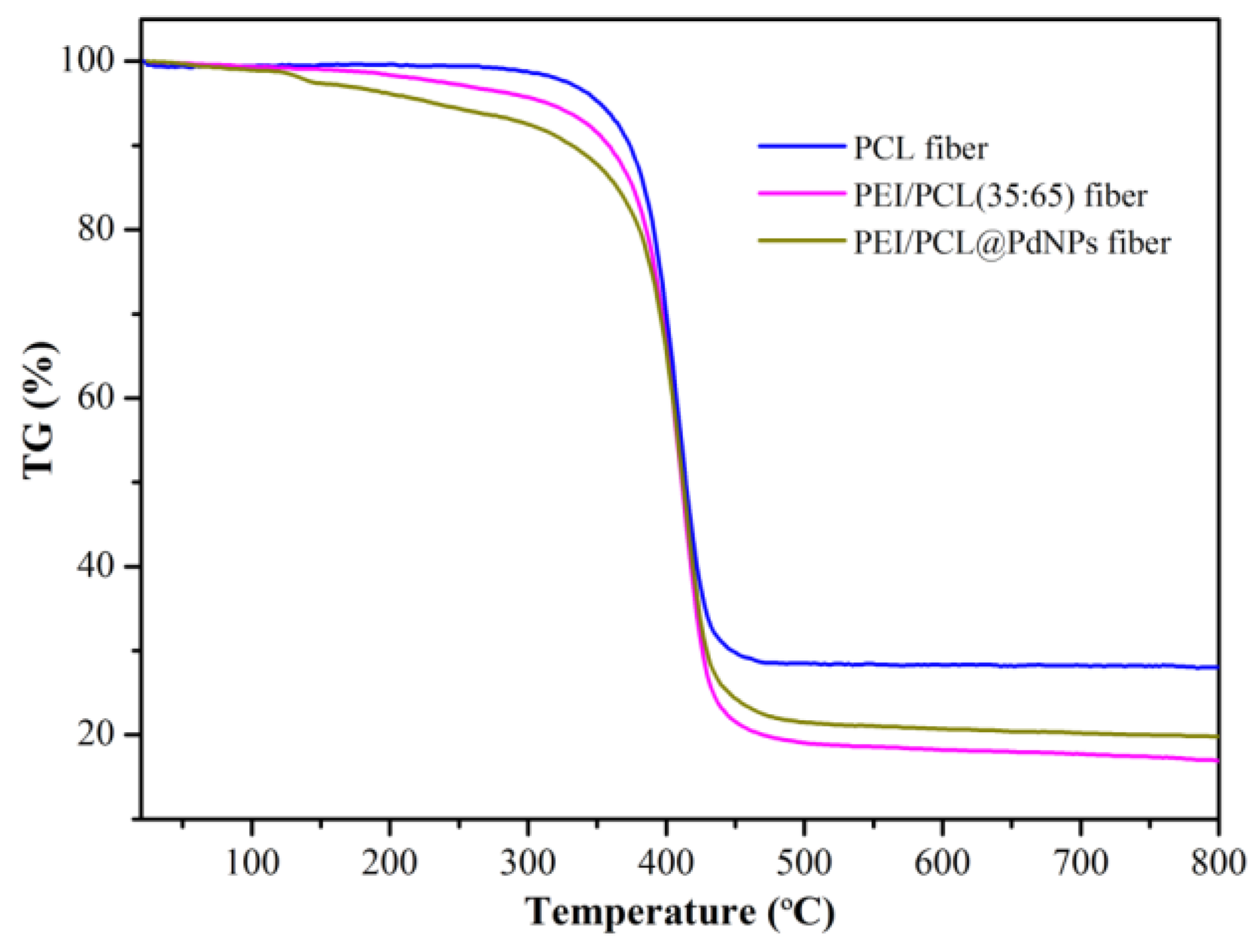
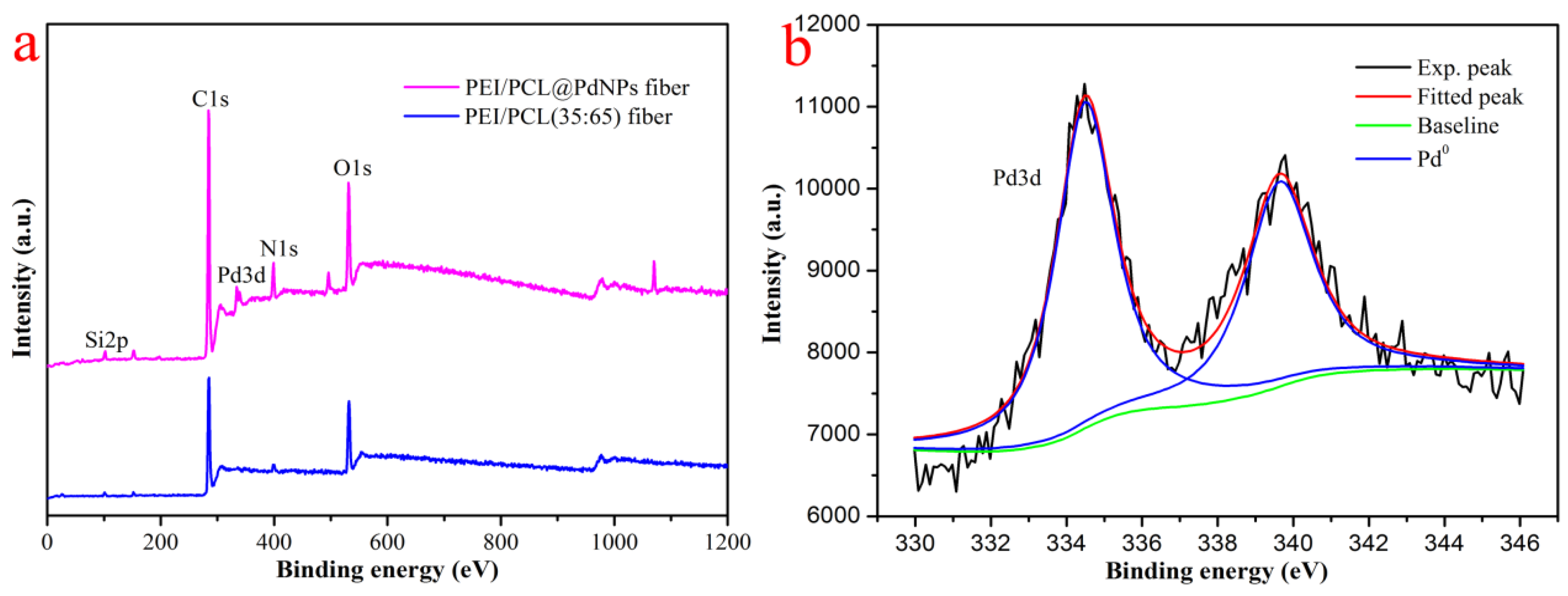
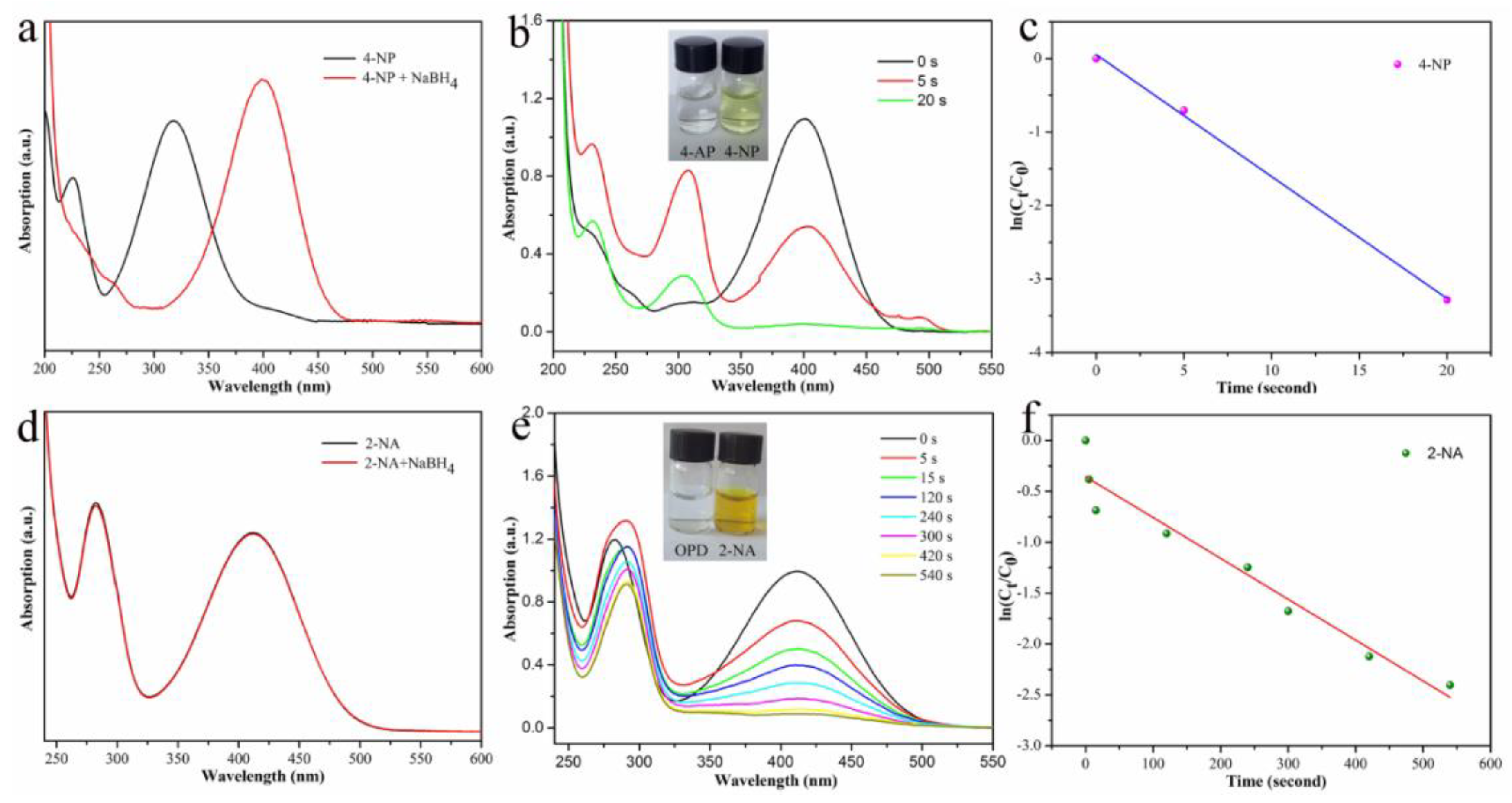
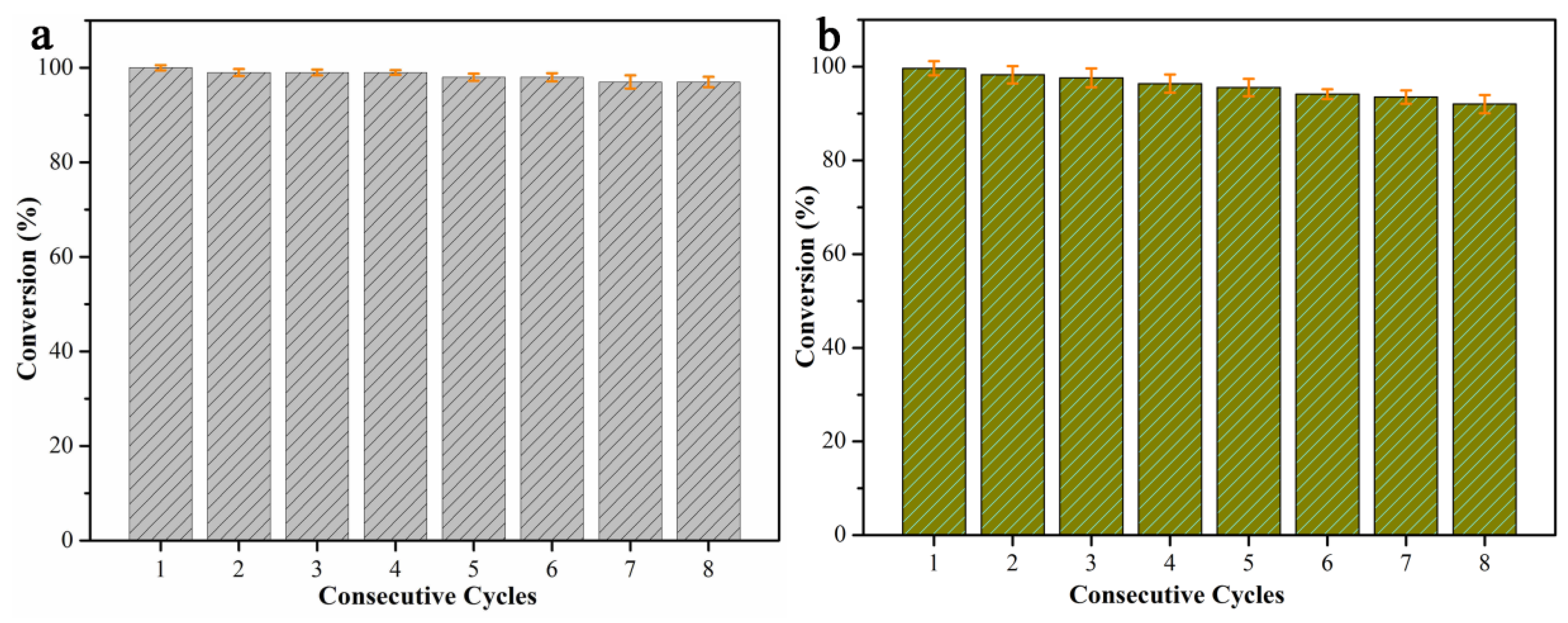
| PEI/PCL Fibers Samples of Different Weight Ratios | Specific Surface Area (m2g−1) | Average Pore Diameter (nm) | Pore Volume (cm3g−1) |
|---|---|---|---|
| 10:90 | 8.34 | 23.83 | 0.00867 |
| 15:85 | 8.84 | 25.31 | 0.00919 |
| 20:80 | 9.73 | 27.86 | 0.01018 |
| 25:75 | 11.16 | 31.92 | 0.01144 |
| 30:70 | 11.82 | 33.56 | 0.01231 |
| 35:65 | 12.93 | 36.85 | 0.01322 |
| NO. | Materials | Kinetic Constant k/ s−1 | Characteristics | Refs |
|---|---|---|---|---|
| 1 | [email protected] NPs | 0.00059 | Natural bioactive black tea extract reducing agent | 17 |
| 2 | CN-supported PdNPs nanohybrids | 0.00570 | Cellulose nanocrystals as support matrix and reducing agent | 18 |
| 3 | AuPdNPs/ graphene nanosheets (GNs) | 0.01445 | Bimetallic nanoparticles, monodisperse method, graphene nanosheet carrier | 19 |
| 4 | nano-silica supported palladium nanocatalyst (Pd/KCC-1) | 0.00800 | Unique dendritic fibrous morphology led to poor aggregation of PdNPs | 20 |
| 5 | Pd/ magnetic porous carbon (MPC) | 0.01200 | Porous carbon composite catalyst carrier, magnetic separation | 45 |
| 6 | carbon nanotubes/ hyperbranched polymers/Pd (CNT/PiHP/Pd) | 0.02630 | Carbon nanotube assisted with hyperbranched polymer support | 46 |
| 7 | Pd/Fe3O4@SiO2@KCC-1(silica nanospheres) | 0.01960 | Core-shell magnetic fibrous nanocatalyst | 47 |
| 8 | Polyethyleneimine(PEI) /Polycaprolactone (PCL)@PdNPs | 0.16597 | Electrospun fibers carrier, simple method | Present work |
© 2019 by the authors. Licensee MDPI, Basel, Switzerland. This article is an open access article distributed under the terms and conditions of the Creative Commons Attribution (CC BY) license (http://creativecommons.org/licenses/by/4.0/).
Share and Cite
Wang, C.; Yin, J.; Han, S.; Jiao, T.; Bai, Z.; Zhou, J.; Zhang, L.; Peng, Q. Preparation of Palladium Nanoparticles Decorated Polyethyleneimine/Polycaprolactone Composite Fibers Constructed by Electrospinning with Highly Efficient and Recyclable Catalytic Performances. Catalysts 2019, 9, 559. https://doi.org/10.3390/catal9060559
Wang C, Yin J, Han S, Jiao T, Bai Z, Zhou J, Zhang L, Peng Q. Preparation of Palladium Nanoparticles Decorated Polyethyleneimine/Polycaprolactone Composite Fibers Constructed by Electrospinning with Highly Efficient and Recyclable Catalytic Performances. Catalysts. 2019; 9(6):559. https://doi.org/10.3390/catal9060559
Chicago/Turabian StyleWang, Cuiru, Juanjuan Yin, Shiqi Han, Tifeng Jiao, Zhenhua Bai, Jingxin Zhou, Lexin Zhang, and Qiuming Peng. 2019. "Preparation of Palladium Nanoparticles Decorated Polyethyleneimine/Polycaprolactone Composite Fibers Constructed by Electrospinning with Highly Efficient and Recyclable Catalytic Performances" Catalysts 9, no. 6: 559. https://doi.org/10.3390/catal9060559





